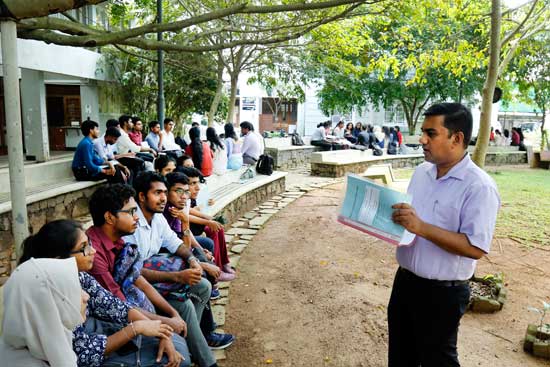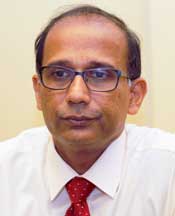Community Medicine: The human face

Refreshing: Lessons learnt in community medicine under the trees in the Medical Faculty’s quadrangle, before the visit to Rahulpura. Pix by M.A. Pushpa Kumara
The families did not come to the doctors, instead the doctors went to the families in their own little homes at Rahulpura in Madiwela.
It was a heartwarming sight on the gloomy and overcast afternoon of November 18 – medical specialists with medical students in tow trudging into a labyrinth of underprivileged homes. Rahulpura falls under the Pita Kotte Medical Officer of Health (MOH) area.
Smiles all round as detailed information is taken about the families and a bond forged……..part of keeping the people healthy and happy.
This is what the Department of Community Medicine, Faculty of Medicine, University of Colombo, has been engaged in not for a few months or years but for 50 years since 1974.
This year, the department established in 1949 has much to celebrate, not just the rapport with the people at ground level but also its 75th anniversary, the highpoint being next Tuesday (December 3).

Prof. Carukshi Arambepola, Dr. Yasaswi Walpita and Dr. Dineshan Ranasinghe finding their way in the maze of homes at Rahulpura
“We provide impactful contributions to all fields as well as training doctors competent in public health to protect and promote health and well-being and research,” said Prof. Upul Senarath, Chair Professor and Head of the Department of Community Medicine, Colombo Faculty of Medicine.
It is at Pita Kotte that the department has introduced several novel practices in the field over the years, some of which have been adopted at national level. These include the introduction of the concept of a monthly conference at MOH level as well as the conducting of ‘Suwa Divi Piyasa’, a clinic for the elderly and an occupational health clinic. Occupational health and safety activities by the department had begun in the 1980s.
Recognition had come in October 2012, when the department was designated as a World Health Organization (WHO) Collaborating Centre for Training and Research in Occupational Health, with the department’s Health Systems Research Unit generating evidence to mould key policy decisions in the health sector in Sri Lanka.

Prof. Upul Senarath
Looking back in time at the evolution of community medicine education, a former Professor of the department, Lalini C. Rajapaksa states in the Journal of the College of Community Physicians of Sri Lanka that teaching public health and preventive medicine to medical students dates back to the establishment of the medical school in 1870. At that time, infectious diseases were the leading cause of mortality and morbidity…….the recommendation to establish a medical school resulted from an investigation into the causes of de-population of the Wanni district of the Northern Province, which identified cholera, endemic fever (malaria) and ‘parangi’ as key causes.
She states: “Dr. William Kynsey who was the Surgeon-Captain in the Army Medical Department and the longest serving head of the Civil Medical Department, in his administrative report for 1886, praised the school for producing ‘doctors who were able to successfully control epidemics in the country’.
On personal experiences in the teaching of public health from 1916-1922, she documents, from the Colombo Medical School Centenary Volume (1870-1970), Dr. E.M. Wijerama recounting how hygiene was taught in the fourth year by Dr. Thornton, Medical Superintendent of the General Hospital, who humorously erased the blackboard with a little saliva on his fingertip.

The Grand Monthly Conference held in the Pita Kotte MOH area on October 18. The Dean of the Medical Faculty, Prof. Vajira H.W. Dissanayake (centre) flanked by (from the left) the Head of the Department of Community Medicine, Prof. Upul Senarath; the Provincial Director of Health Services – Western Province, Dr.Dhammika Jayalath; the Provincial Health Secretary - Western Province, L.A. Kalukapuarachchi; and the Deputy Director General Public Health Services – 1, Dr. S.M. Arnold
According to her, in the 1930s students had been taken on visits to various sites where demonstrations had to be recorded in a notebook accompanied by diagrams or photographs and submitted for correction and comments. They had also had exposure to infectious diseases at the Infectious Diseases Hospital, Angoda, Leprosy Hospital, Kandana, and Chest Hospital, Welisara. Then in the 1940s, the first batch of students had undergone a two-week resident appointment in public health at the premier MOH unit at Kalutara. The MOH at the time, Dr. O.E.R. Abhayaratne would later become the first Professor of Public Health and Preventive Medicine.
Helminthiasis and diarrhoeal disease were the common causes of mortality and morbidity among young children in the 1950s and early 1960s, states Prof. Rajapaksa, with the students having to learn about sanitation, including the features of squatting plates and safe wells. The department had also collaborated with the Department of Paediatrics in an “interesting” programme called ‘social paediatrics’ introduced as part of the Paediatric Professorial appointment.

The medical students collecting information in a household
“The creation of a field practice area for the Faculty of Medicine, Colombo in 1974 was an important milestone, enabling students to undertake a two-week rotation in community medicine providing them an opportunity to observe and participate in activities of the MOH area and learn about roles, responsibilities and services provided by the MOH and his team,” she points out, explaining that from 1980 to the mid-1990s, the focus expanded to include the emergence of non-communicable diseases (NCDs).

The staff of the Department of Community Medicine comprising Head Prof. Upul Senarath, nine academic staff members, two demonstrators, a social service instructor, seven non-academic staff members and four post graduate trainees
Prof. Rajapaksa adds that in 1996, there was a “major” shift in medical education – from a traditional one to a student-centred problem-based curriculum. Novel teaching-learning methods were incorporated to enhance learning experiences outside the classroom, with more opportunities to gain knowledge and acquire skills through community engagement in both urban and rural settings.
Meanwhile, the department has been a hub for international collaborations and networks such as the Asia-Pacific Academic Consortium for Public Health (APACPH), the Southeast Asia Public Health Educational Institutions Network (SEAPHEIN); and the South Asia Infant Feeding Research Network (SAIFRN). It has also had collaborative projects with agencies such as WHO, UNICEF (the UN agency for children), UNFPA (UN Population Fund) and the World Bank.
| 75th anniversary celebrations | |
| The main anniversary celebration on December 3 at the auditorium of the Faculty of Medicine will see the participation of more than 300 distinguished guests.The special guests will include the Past President of the British Medical Association and Emeritus Prof. Sir Sabaratnam Arulkumaran from the United Kingdom; the Vice Chancellor of the University of Colombo, Prof. H.D. Karunaratne; the Dean of the Faculty of Medicine, University of Colombo, Prof. Vajira H.W. Dissanayake; the Education, Higher Education and Vocational Education Ministry Secretary Nalaka Kaluwewe and the WHO Representative to Sri Lanka, Dr. Alaka Singh.A souvenir along with department research publications and a series of other documents will be released during the ceremony.A ‘Grand Monthly Conference’ at the Pita Kotte MOH office has already been held, while a photography and art competition on the theme ‘Public Health’ will be opened by veteran artist Dayan Witharana tomorrow at the Ground Floor of the UCFM tower.
|
Searching for an ideal partner? Find your soul mate on Hitad.lk, Sri Lanka's favourite marriage proposals page. With Hitad.lk matrimonial advertisements you have access to thousands of ads from potential suitors who are looking for someone just like you.


